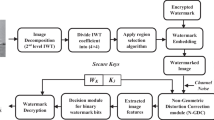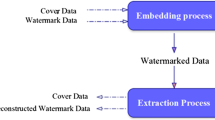Abstract
This paper proposes a new orthogonal frequency division multiplexing (OFDM) system, based on discrete cosine harmonic wavelet (DCHWT) for PSK and 16-QAM modulated signals. This system uses energy compaction property of discrete cosine transform (DCT) that provides low leakage in subcarriers. DCHWT based OFDM system provides improved performance in terms of bit error rate (BER) and reduction in the peak to average power ratio (PAPR) compared to conventional cyclic prefix (CP) based Fourier transform OFDM (DFT-OFDM). Application of \(\upmu \)-law companding to proposed system further improves the PAPR performance. The complementary cumulative distribution (CCDF) plots corroborate the same. BER performance is on par or better than that of Haar wavelet based OFDM in addition to improvement in PAPR. PAPR improved is in the range of 0.8–2.3 dB compared to Haar and DFT OFDM respectively, with remarkable improvement in BER. Proposed method is simple, does not require explicit decimation, interpolation, associated filtering and delay compensation for reconstruction, compared to other time domain wavelet transforms.










Similar content being viewed by others
References
Cho, Y. S., Kim, J., Yang, W. Y., & Kang, C.-G. (2010). MIMO OFDM wireless communications with Matlab. London: Wiley (IEEE press).
Prasad, R. OFDM for wireless communications systems. Artech House, ISBN 1-58053-796-0.
Mandyam, G. (2003). On the discrete cosine transform and OFDM system. ICASSP.
Mandyam, G. (2004). Sinusoidal transforms in OFDM systems. IEEE Transactions on Broadcasting, 50(2), 172–184.
Lakshmanan, M. K., & Nikookar, H. (2006). A review of wavelets for digital wireless communications. Berlin: Springer. (Wireless Personal Communications).
Mirghani, R., & Ghavami, M. (2008). Comparison between wavelet-based and Fourier-based multicarrier UWB systems. IET Communications, 2(2), 353–358.
Lin, Y. P., Phoong, S. M., & Vaidyanathan, P. P. (2011). Filter bank transcivers for OFDM and DMT systems. Cambridge: Cambridge University Press.
Linfoot, S. L. (2008). A study of different wavelets in orthogonal wavelet division multiplex for DVB-T. IEEE Transactions on Consumer Electronics, 54(3), 1042–1047.
Nagesh, B. G., & Nikookar, H. (2001). Wavelet based OFDM for wireless channels Vol. 1. In Vehicular technology conference.
Newland, D. E. (1993). Harmonic wavelet analysis. Proceedings of the Royal Society of London. Series A, 444, 203–225.
Narasimhan, S. V., & Harish, M. (2006). A new spectral estimator based on discrete cosine transform and modified group delay. Signal Processing, 86(7), 1586–1596.
Narasimhan, S. V., Harish, M., Haripriya, A. R., & Basumallick, N. (2009). Discrete cosine harmonic wavelet transform and its application to signal compression and subband spectral estimation using modified group delay. Signal, Image and Video Processing, 3(1), 85–99.
Narasimhan, S. V., Basumallik, N., & Veena, S. (2011). Introduction to wavelet transform: A signal processing approach. Narosa Publishing House.
Suma, M. N., Narasimhan, S. V., & Kanmani, B. (2012). The OFDM system based on discrete cosine harmonic wavelet transform. In National communications conference-NCC2012, Indian Institute of Technology, Kharagpur, India. February 3–4, 2012.
Jiang, T., & Zhu, G. (2004). Nonlinear companding transform for reducing peak-to-average power ratio of OFDM signals. IEEE Transactions on Broadcasting, 50(3), 342–346.
Gao, W., Yan, Y., Osadciw, L., Duan, C., & Li, C. (2010). A two stage PAPR reduction method on frequency redundant OFDM system. TR2010-048, MITSUBISHI ELECTRIC RESEARCH LABORATORIES.
Wang, Z. (2011). Combined DCT and companding for PAPR reduction in OFDM signals. Journal of Signal and Information Processing, 2, 100–104.
Proakis, J. G. (2001). Digital communications (4th ed.). Boston, MA: McGraw-Hill.
Author information
Authors and Affiliations
Corresponding author
Rights and permissions
About this article
Cite this article
Suma, M.N., Narasimhan, S.V. & Kanmani, B. A New OFDM System Based on Discrete Cosine Harmonic Wavelet Transform (DCHWT) for PSK and QAM. Wireless Pers Commun 80, 1733–1746 (2015). https://doi.org/10.1007/s11277-014-2110-7
Published:
Issue Date:
DOI: https://doi.org/10.1007/s11277-014-2110-7




